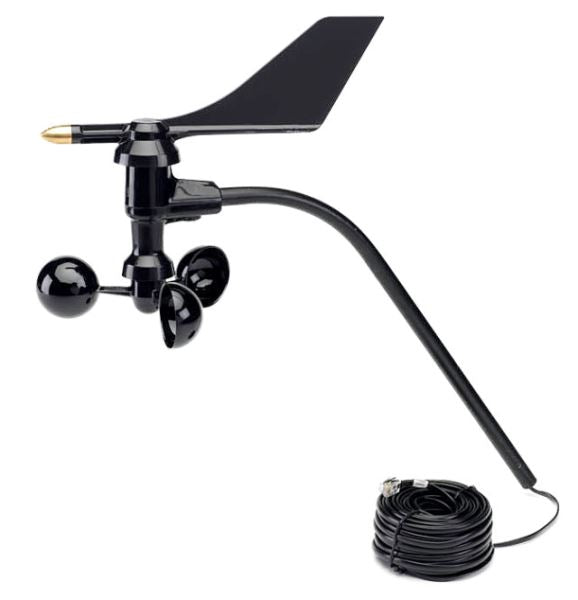Professional Tips for Adjusting Your Anemometer for Optimal Performance
Professional Tips for Adjusting Your Anemometer for Optimal Performance
Blog Article
All You Required to Learn About Anemometers: Just How They Function, Why They Issue, and Where to Use Them
Anemometers, though commonly ignored in the world of scientific tools, play a crucial role in different areas, providing valuable understandings right into wind rate and air movement patterns. As we dig into the details of anemometer modern technology, we will certainly reveal the inner functions of these gadgets, their importance, and the vital considerations when picking the best anemometer for certain applications.

Anemometer Essentials
A crucial instrument utilized to gauge wind rate and instructions, the anemometer plays a crucial duty in weather forecasting and numerous sectors. An anemometer typically contains 3 or four mugs that turn in the wind, a vane that directs into the wind, and sensing units to track the activities or turnings. By determining the rotations or activities over a details period, the anemometer can establish wind speed. The vane helps establish wind direction by aiming right into the wind, giving valuable data for climate forecasting, aeronautics, maritime procedures, environmental tracking, and wind power applications.
There are numerous types of anemometers available, consisting of mug anemometers, vane anemometers, hot-wire anemometers, and sonic anemometers, each with its unique features and applications. Cup anemometers are frequently used for fundamental wind speed dimensions, while vane anemometers are preferred for directional measurements.
Principles of Anemometer Operation
Building on the foundational understanding of anemometer fundamentals, the principles of anemometer operation illuminate the mechanics behind wind speed and direction dimensions. Mug anemometers, for circumstances, have three or even more cups that capture the wind, causing them to spin quicker as the wind speed increases. Hot-wire anemometers count on a heated wire that cools down as wind passes over it, with the rate of cooling down figuring out the wind speed.
Value of Anemometers
The significance of anemometers in weather forecasting and numerous markets can not be overstated. Anemometers play a critical function in determining wind rate and instructions, giving important information for weather condition projecting, climate studies, environmental tracking, and aviation procedures. Meteorologists rely on anemometers to gather exact wind data, assisting them recognize weather condition patterns, forecast tornados, and concern timely cautions to the public. In sectors such as construction, agriculture, renewable resource, and maritime operations, anemometers are utilized to enhance processes, ensure security, and increase performance. Wind ranch drivers utilize anemometers to assess wind problems and optimize electrical energy production from wind generators. In the maritime market, anemometers help ship navigation by offering real-time wind info to captains, aiding them make informed decisions to ensure secure voyages. Overall, anemometers are important tools that add considerably to security, performance, and informed decision-making in weather forecasting and a vast array of markets.
Applications Throughout Numerous Industries
In the eco-friendly energy sector, anemometers play a critical function in analyzing wind conditions for wind ranch placements, ensuring optimal energy production. Industries like building and construction and mining utilize anemometers to check wind rates, important for safety and security methods, especially when working More Bonuses at elevations or in open-pit mines where strong winds can posture threats. In agriculture, anemometers help farmers in handling crop spraying by giving real-time data on wind rate to avoid drift.

Choosing the Right Anemometer for Your Requirements
Choosing the ideal anemometer customized to your certain requirements is essential for obtaining exact wind speed and instructions dimensions. When choosing an anemometer, take into consideration factors such as the designated application, called for dimension array, environmental conditions, and preferred attributes. For general functions, a cup anemometer appropriates navigate to these guys for measuring wind speed, while a vane anemometer offers wind direction information. Hot-wire anemometers are excellent for low airspeed measurements, and ultrasonic anemometers provide high precision and sturdiness.

Conclusion
In verdict, anemometers play a crucial role in gauging wind rate and instructions throughout various industries. Comprehending the principles of anemometer operation is vital for selecting the right device for certain demands. From meteorology to aviation, anemometers are important tools for accumulating accurate data and making sure safety and security in different applications. When choosing the most suitable device for gauging wind problems., it is vital to think about the importance of anemometers in order to make enlightened choices.
There are various types of anemometers available, consisting of cup anemometers, vane anemometers, hot-wire anemometers, and sonic anemometers, each with its special functions and applications. Mug anemometers are generally look at this now used for basic wind rate measurements, while vane anemometers are preferred for directional dimensions. Hot-wire anemometers are suitable for reduced airspeeds, and sonic anemometers are optimal for high-precision dimensions in research and commercial settings.Structure on the fundamental understanding of anemometer fundamentals, the principles of anemometer operation clarify the technicians behind wind rate and direction dimensions. For basic objectives, a mug anemometer is ideal for gauging wind speed, while a vane anemometer gives wind direction information.
Report this page